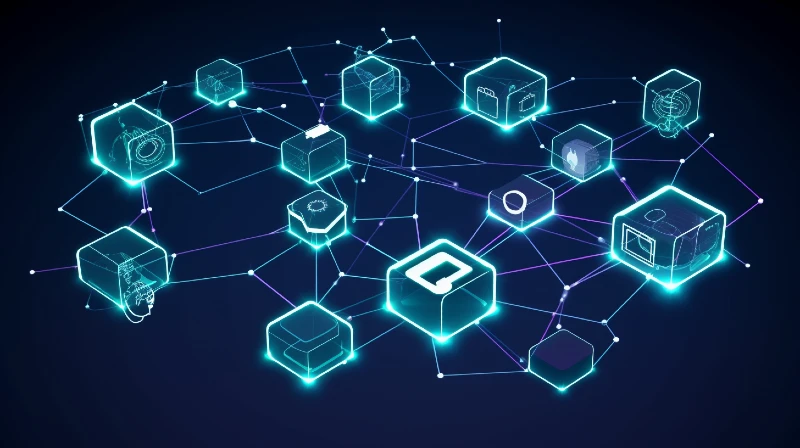In today’s rapidly evolving digital landscape, the convergence of cutting-edge technologies has the potential to revolutionize industries and drive innovation. Two such technologies, Blockchain and the Internet of Things (IoT), are making significant strides in transforming the way businesses operate, interact, and create value. This article delves into the opportunities and challenges that emerge from the integration of Blockchain and IoT, providing a comprehensive understanding of their synergistic potential.
As the number of connected devices continues to skyrocket, the IoT ecosystem is becoming increasingly complex, necessitating robust solutions to manage and secure the vast amounts of data generated. Simultaneously, Blockchain has emerged as a revolutionary technology that promises enhanced security, transparency, and decentralization.
By exploring the intersections between these two technologies, this article will reveal the enormous potential for positive disruption and outline the path forward for organizations seeking to harness the power of Blockchain and IoT.
Understanding Blockchain and IoT: The Core Concepts
Before diving into the opportunities and challenges that arise from integrating Blockchain and IoT, it is crucial to understand the core concepts and principles underpinning these technologies.
Blockchain, at its essence, is a decentralized, distributed ledger technology (DLT) that enables secure and transparent transactions without the need for a central authority. Each transaction is grouped into a block, which is cryptographically linked to the previous block in the chain, ensuring data integrity and immutability. Key features of Blockchain include:
- Decentralization: No single entity has control over the entire network, reducing the risk of a single point of failure and increasing overall system resilience.
- Consensus mechanisms: Network participants validate transactions through consensus algorithms, such as Proof of Work (PoW) or Proof of Stake (PoS), ensuring the network’s security and trustworthiness.
- Smart contracts: Self-executing contracts with coded terms and conditions that enable automated, trustless transactions between parties.
The Internet of Things (IoT), on the other hand, refers to the interconnected network of physical devices, vehicles, buildings, and other objects embedded with sensors, software, and connectivity. These devices collect, exchange, and analyze data, enabling seamless communication and interaction between the digital and physical worlds. Core components of IoT include:
- Sensors and actuators: Devices that collect and transmit data from the environment or perform actions based on specific input.
- Connectivity: Devices communicate through various communication protocols such as Wi-Fi, Bluetooth, or cellular networks.
- Data processing and analysis: IoT platforms collect and process data from devices, providing insights for decision-making or triggering automated actions.
Understanding these fundamental concepts is essential for grasping the potential benefits and challenges that arise when integrating Blockchain and IoT technologies. The next section will explore the opportunities that emerge from their synergy.
|
Component |
Blockchain |
IoT |
|
Purpose |
Decentralized, secure data storage and transactions |
Interconnected network of devices collecting and sharing data |
|
Key Features |
Decentralization, consensus mechanisms, smart contracts |
Sensors, connectivity, data processing and analysis |
|
Primary Benefits |
Security, transparency, automation, trustlessness |
Improved efficiency, real-time data, automation |
Table 1: Comparison of Blockchain and IoT Core Components
Opportunities: How Blockchain Enhances the IoT Ecosystem
The integration of Blockchain and IoT technologies can unlock unprecedented opportunities for businesses, governments, and individuals by enhancing various aspects of the IoT ecosystem. Here, we outline some of the most notable opportunities:
- Improved data security: IoT devices often generate sensitive data, making them attractive targets for cyberattacks. Blockchain’s decentralized nature, coupled with its cryptographic security features, can help secure IoT devices and protect data from unauthorized access, tampering, or alteration.
- Device identity management: As the number of connected devices grows, ensuring their authenticity and accurate identification becomes crucial. Blockchain can facilitate secure and unique device identity management, enabling transparent device tracking and preventing unauthorized access or spoofing.
- Supply chain transparency: IoT devices can track products and materials throughout the supply chain, providing valuable data on the origin, quality, and status of goods. By storing this data on a Blockchain, stakeholders can access verifiable, tamper-proof information that promotes transparency and builds trust among parties.
- Decentralized decision-making: Blockchain enables the creation of decentralized autonomous organizations (DAOs) that can govern IoT ecosystems without the need for a central authority. This approach fosters increased efficiency and responsiveness, as devices can make decisions and execute actions based on predefined rules and consensus mechanisms.
- New business models and revenue streams: The integration of Blockchain and IoT can facilitate innovative business models such as asset sharing, decentralized marketplaces, and micropayments. For example, IoT devices can leverage Blockchain-based tokens to enable pay-per-use models or incentivize users to share resources, such as excess storage or processing power.
These opportunities highlight the immense potential for value creation and innovation that emerges from combining Blockchain and IoT technologies. However, realizing this potential also comes with its fair share of challenges, which we will discuss in the next section.
|
Opportunity |
Description |
Benefit |
|
Improved data security |
Enhanced protection of IoT data through cryptographic security features |
Greater trust and reduced risk of data breaches |
|
Device identity management |
Secure and unique identification of IoT devices |
Better tracking and prevention of unauthorized access |
|
Supply chain transparency |
Tamper-proof tracking of goods and materials throughout the supply chain |
Improved traceability and trust among stakeholders |
|
Decentralized decision-making |
Autonomous governance of IoT ecosystems without central authority |
Increased efficiency and responsiveness |
|
New business models |
Innovative revenue streams and business models such as asset sharing and decentralized marketplaces |
Expanded opportunities and economic growth |
Table 2: Opportunities and Benefits of Blockchain-IoT Integration
Challenges: Overcoming Obstacles in Blockchain and IoT Integration
While the integration of Blockchain and IoT holds immense promise, it also presents several challenges that must be addressed to unlock their full potential. The following are some of the most significant obstacles:
- Scalability: As the number of connected IoT devices continues to grow, Blockchain networks must be able to handle a massive increase in transactions. Traditional consensus mechanisms like Proof of Work can be resource-intensive, limiting their suitability for large-scale IoT applications. Solutions such as layer 2 protocols, sharding, and alternative consensus mechanisms are being explored to address this issue.
- Interoperability: With a plethora of IoT devices, communication protocols, and Blockchain platforms, seamless interaction between different systems is critical. Developing standardized data formats and cross-chain communication protocols will be essential to ensure smooth information exchange and collaboration.
- Energy consumption: The energy requirements of some Blockchain consensus mechanisms, particularly Proof of Work, can be significant. This concern is especially relevant in the context of IoT, where many devices operate on limited power sources. Exploring energy-efficient consensus algorithms and optimizing system design can help mitigate this challenge.
- Privacy concerns: While Blockchain offers enhanced transparency, it may also raise privacy concerns, especially when handling sensitive data generated by IoT devices. Implementing privacy-preserving techniques, such as zero-knowledge proofs or confidential transactions, can help balance the need for transparency and privacy.
- Regulatory hurdles: As with any emerging technology, regulatory frameworks for Blockchain and IoT are still evolving. Navigating complex and sometimes conflicting regulations across different jurisdictions can be challenging for organizations. Engagement with regulators and the development of clear, technology-neutral legislation will be crucial to facilitate widespread adoption.
By addressing these challenges and working collaboratively to develop effective solutions, the integration of Blockchain and IoT can be accelerated, paving the way for a more secure, efficient, and decentralized future.
|
Challenge |
Description |
Potential Solution |
|
Scalability |
Handling increased transactions and data as IoT networks grow |
Layer 2 protocols, sharding, alternative consensus mechanisms |
|
Interoperability |
Seamless interaction between diverse IoT devices, communication protocols, and Blockchain platforms |
Standardized data formats, cross-chain communication protocols |
|
Energy consumption |
Reducing energy requirements of consensus mechanisms |
Energy-efficient consensus algorithms, system optimization |
|
Privacy concerns |
Balancing transparency and privacy in handling sensitive IoT data |
Zero-knowledge proofs, confidential transactions |
|
Regulatory hurdles |
Navigating complex and evolving regulatory frameworks |
Collaboration with regulators, technology-neutral legislation |
Table 3: Challenges and Potential Solutions in Blockchain-IoT Integration
Case Studies: Real-World Applications of Blockchain and IoT
To better illustrate the potential of Blockchain and IoT integration, let’s explore a few real-world case studies across various industries:
- Supply Chain Management: Companies like IBM and Walmart have successfully implemented a Blockchain-based IoT solution to track food products from farm to store shelves. IoT sensors monitor temperature, location, and other relevant data, while Blockchain ensures the data’s integrity and provenance, improving traceability and reducing the risk of foodborne illness outbreaks.
- Smart Cities: The city of Taipei has partnered with the IOTA Foundation to create a smart city initiative that leverages IoT and Blockchain technologies. IoT sensors monitor air quality, while Blockchain ensures the data’s authenticity and reliability. This information is then used to make data-driven decisions to improve the city’s environment and living conditions.
- Healthcare: MediLedger, a consortium of major pharmaceutical companies, uses a Blockchain-based IoT solution to combat counterfeit drugs. IoT devices scan and verify the authenticity of medication packaging, and Blockchain securely stores the data, ensuring that counterfeit products are detected and removed from the supply chain.
- Energy: Power Ledger, an Australian company, has developed a platform that combines Blockchain and IoT to enable decentralized energy trading. IoT-enabled smart meters measure and track energy production and consumption, while Blockchain facilitates peer-to-peer trading of excess energy, promoting renewable energy adoption and reducing reliance on traditional power grids.
These case studies demonstrate the diverse range of applications and industries that can benefit from the integration of Blockchain and IoT technologies. By examining these real-world examples, we can gain insights into the potential for innovation and value creation in a variety of sectors.
Future Outlook: The Path Forward for Blockchain and IoT
As Blockchain and IoT technologies continue to mature, their integration will likely bring about even more opportunities and advancements across various sectors. The future outlook for these combined technologies is promising, with several trends and developments expected to shape their growth:
- Standardization and collaboration: As the adoption of Blockchain and IoT increases, the need for standardized protocols and data formats will become increasingly important. Industry consortia and cross-sector collaborations will play a crucial role in developing unified frameworks that facilitate interoperability and streamline adoption.
- Advances in consensus mechanisms: Addressing the scalability and energy consumption challenges will require innovative consensus mechanisms. Research into alternative approaches, such as Proof of Stake, Directed Acyclic Graphs (DAGs), and layer 2 scaling solutions, will likely accelerate to accommodate the growing demands of IoT networks.
- Enhanced privacy and security features: As privacy concerns and security threats become more prominent, novel cryptographic techniques and privacy-preserving technologies will emerge. These advancements will help strike a balance between transparency and privacy, ensuring that sensitive data remains protected while still enabling trust and collaboration.
- Machine-to-Machine (M2M) economy: The integration of Blockchain and IoT will enable new economic models based on M2M transactions. IoT devices could autonomously conduct transactions, participate in decentralized marketplaces, and utilize micropayment systems, ushering in a new era of economic activity driven by machines.
- Edge computing and Artificial Intelligence (AI) integration: The fusion of Blockchain, IoT, edge computing, and AI technologies will lead to more sophisticated and intelligent systems. Edge computing can help alleviate the burden on networks by processing data closer to the source, while AI can facilitate data analysis and decision-making in decentralized IoT networks.
The path forward for Blockchain and IoT is filled with exciting possibilities and opportunities for innovation. By working together, stakeholders from various industries, research institutions, and governments can overcome the challenges and unlock the full potential of these transformative technologies.
|
Year |
Market Value (USD Billion) |
Source |
|
2018 |
0.168 |
[1] MarketsandMarkets |
|
2020 |
0.258 |
[1] MarketsandMarkets |
|
2024 |
3.0 |
[2] Global Market Insights |
|
2025 |
5.802 |
[1] MarketsandMarkets |
|
2026 |
6.0 |
[3] Verified Market Research |
Table 4: Predicted Market Value of IoT and Blockchain Integration
Conclusion
The integration of Blockchain and IoT technologies presents a compelling opportunity to revolutionize industries, enhance security, and enable new business models. Throughout this article, we have examined the core concepts underpinning these technologies, the opportunities they offer when combined, the challenges that need to be addressed, and several real-world applications that showcase their potential.
The future outlook for Blockchain and IoT is undoubtedly promising, with ongoing research and development efforts focused on addressing scalability, interoperability, energy consumption, privacy, and regulatory concerns. As these technologies continue to evolve, we can expect to see increased standardization, collaboration, and innovation, driving the emergence of new economic models and transforming various sectors.
In conclusion, the marriage of Blockchain and IoT has the potential to create tremendous value and positively disrupt numerous industries. By staying informed and actively participating in the ongoing development and adoption of these technologies, businesses, governments, and individuals can seize the opportunities they present and contribute to shaping a more secure, efficient, and decentralized future.
Sources:
[1] MarketsandMarkets. (2018). “Blockchain IoT Market by Offering (Hardware, Software, and Infrastructure Provider), Application (Smart Contract, Data Security, Data Sharing/Communication, and Asset Tracking & Management), End User, and Geography – Global Forecast to 2025.” Retrieved from: https://www.marketsandmarkets.com/Market-Reports/blockchain-iot-market-168941858.html
[2] Global Market Insights. (2019). “Blockchain Technology in the Energy Sector Market Size By Category, By Exchange Type, By Application, Industry Analysis Report, Regional Outlook, Growth Potential, Competitive Market Share & Forecast, 2018 – 2024.” Retrieved from: https://www.gminsights.com/industry-analysis/blockchain-technology-in-energy-sector-market
[3] Verified Market Research. (2020). “Blockchain IoT Market by Offering, by Application, by Geographic Scope and Forecast.” Retrieved from: https://www.verifiedmarketresearch.com/product/blockchain-iot-market/




